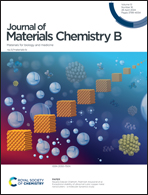pH-responsive iron-loaded carbonaceous nanoparticles for chemodynamic therapy based on the Fenton reaction†
Abstract
The Fenton reaction-based chemodynamic therapy is a form of cancer therapy, and its efficacy can be significantly improved by promoting catalytic reactions involving iron ions. A system with high catalytic capacity and low biological toxicity that effectively inhibits tumor progression is required for optimal treatment. In this study, iron-loaded carbonaceous nanoparticles (CNPs@Fe) with Fenton catalytic activity were fabricated and applied for the chemodynamic therapy of cancer. The carbonaceous nanoparticles derived from glucose via a caramelization reaction demonstrated high biocompatibility. Besides, aromatic structures in the carbonaceous nanoparticles helped accelerate electron transfer to enhance the catalytic decomposition of H2O2, resulting in the formation of highly reactive hydroxyl radicals (˙OH). At pH 6.0 (representing weak acidity in the tumor microenvironment), the Fenton catalytic activity of CNPs@Fe in the decomposition of H2O2 was 15.3 times higher than that of Fe2+ and 28.3 times higher than that of Fe3O4via a chromogenic reaction. The reasons for the enhancement were revealed by analyzing the chemical composition of carbonaceous nanoparticles using high-resolution mass spectra. The developed Fenton agent also demonstrated significant therapeutic effectiveness and minimal side effects in in vitro and in vivo anticancer studies. This work proposes a novel approach to promote the generation of reactive oxygen species (ROS) for the chemodynamic therapy of cancer.



 Please wait while we load your content...
Please wait while we load your content...